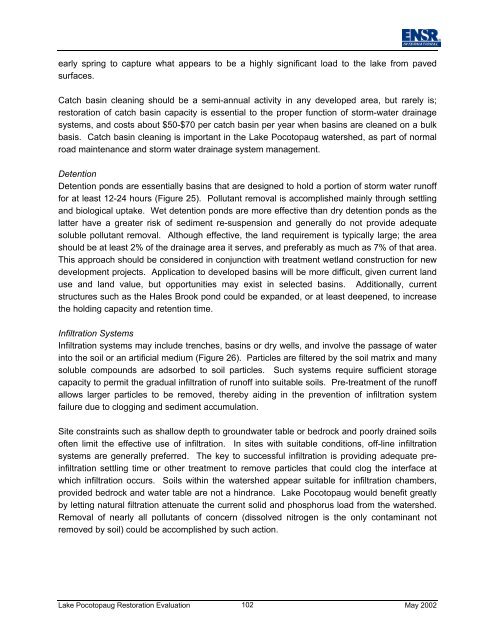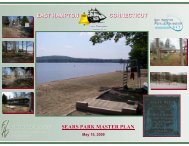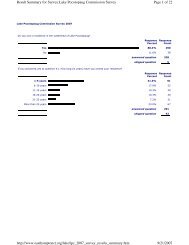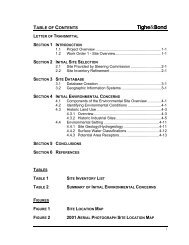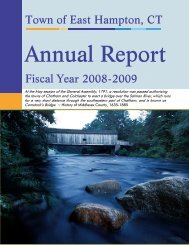Lake Pocotopaug Lake and Watershed Restoration Evaluation ...
Lake Pocotopaug Lake and Watershed Restoration Evaluation ...
Lake Pocotopaug Lake and Watershed Restoration Evaluation ...
Create successful ePaper yourself
Turn your PDF publications into a flip-book with our unique Google optimized e-Paper software.
early spring to capture what appears to be a highly significant load to the lake from pavedsurfaces.Catch basin cleaning should be a semi-annual activity in any developed area, but rarely is;restoration of catch basin capacity is essential to the proper function of storm-water drainagesystems, <strong>and</strong> costs about $50-$70 per catch basin per year when basins are cleaned on a bulkbasis. Catch basin cleaning is important in the <strong>Lake</strong> <strong>Pocotopaug</strong> watershed, as part of normalroad maintenance <strong>and</strong> storm water drainage system management.DetentionDetention ponds are essentially basins that are designed to hold a portion of storm water runofffor at least 12-24 hours (Figure 25). Pollutant removal is accomplished mainly through settling<strong>and</strong> biological uptake. Wet detention ponds are more effective than dry detention ponds as thelatter have a greater risk of sediment re-suspension <strong>and</strong> generally do not provide adequatesoluble pollutant removal. Although effective, the l<strong>and</strong> requirement is typically large; the areashould be at least 2% of the drainage area it serves, <strong>and</strong> preferably as much as 7% of that area.This approach should be considered in conjunction with treatment wetl<strong>and</strong> construction for newdevelopment projects. Application to developed basins will be more difficult, given current l<strong>and</strong>use <strong>and</strong> l<strong>and</strong> value, but opportunities may exist in selected basins. Additionally, currentstructures such as the Hales Brook pond could be exp<strong>and</strong>ed, or at least deepened, to increasethe holding capacity <strong>and</strong> retention time.Infiltration SystemsInfiltration systems may include trenches, basins or dry wells, <strong>and</strong> involve the passage of waterinto the soil or an artificial medium (Figure 26). Particles are filtered by the soil matrix <strong>and</strong> manysoluble compounds are adsorbed to soil particles. Such systems require sufficient storagecapacity to permit the gradual infiltration of runoff into suitable soils. Pre-treatment of the runoffallows larger particles to be removed, thereby aiding in the prevention of infiltration systemfailure due to clogging <strong>and</strong> sediment accumulation.Site constraints such as shallow depth to groundwater table or bedrock <strong>and</strong> poorly drained soilsoften limit the effective use of infiltration. In sites with suitable conditions, off-line infiltrationsystems are generally preferred. The key to successful infiltration is providing adequate preinfiltrationsettling time or other treatment to remove particles that could clog the interface atwhich infiltration occurs. Soils within the watershed appear suitable for infiltration chambers,provided bedrock <strong>and</strong> water table are not a hindrance. <strong>Lake</strong> <strong>Pocotopaug</strong> would benefit greatlyby letting natural filtration attenuate the current solid <strong>and</strong> phosphorus load from the watershed.Removal of nearly all pollutants of concern (dissolved nitrogen is the only contaminant notremoved by soil) could be accomplished by such action.<strong>Lake</strong> <strong>Pocotopaug</strong> <strong>Restoration</strong> <strong>Evaluation</strong> 102May 2002


